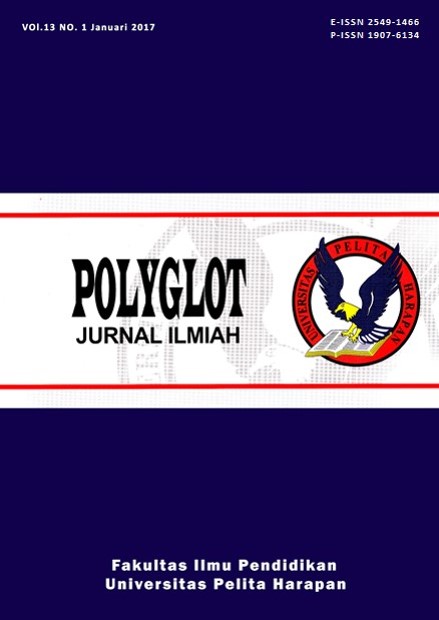Code Switching in BIPA Classes: Teachers' and Students’ Attitudes
DOI:
https://doi.org/10.19166/pji.v13i1.356Keywords:
attitudes, code-switching, BIPA, L1, L2, teaching and learning processAbstract
The controversy of using L1 or L2 only in second language classes has been widely discussed in many studies. Some teachers, however, opt for the middle ground by employing the bilingual approach; they practice code switching to some extent to facilitate teaching learning process. In the context of BIPA teaching and learning this issue has not been sufficiently addressed. Therefore, this study seeks to explore the teachers as well as the students’ attitude towards the practice of code-switching in BIPA classes, specifically in the basic level classes. The factors behind its practice will also be discussed in the light of its benefit and hindrance for teaching learning process. This study employed a quantitative research design by conducting a survey and a qualitative research design by interpreting the result of the interview with the teachers and students. In general the study indicates the need of code-switching to support teaching and learning process, especially for the beginner level classes.
BAHASA INDONESIA ABSTRAK: Kontroversi penggunaan hanya bahasa pertama atau bahasa kedua dalam kelas bahasa kedua telah banyak dibahas dalam banyak penelitian. Meskipun demikian, sebagian pengajar memilih jalan tengah dengan menggunakan pendekatan dwi-bahasa; mereka menggunakan alih kode sampai kadar tertentu untuk memudahkan proses belajar mengajar. Dalam konteks belajar mengajar BIPA isu ini kurang banyak dibahas. Karena itu, studi ini ingin mengkaji sikap para pengajar maupun pelajar terhadap praktek alih kode di kelas BIPA, khususnya di kelas tingkat dasar. Faktor-faktor di balik praktek tsb juga akan dibahas dalam perspektif kelebihan dan kekurangannya untuk proses belajar mengajar. Penelitian ini bersifat kuantitatif dengan mengadakan survei dan juga kualitatif dengan melakukan intepretasi terhadap hasil wawancara dengan pengajar dan pelajarnya. Secara umum, studi ini mengindikasikan perlunya alih kode untuk mendukung proses belajar mengajar, khusunya untuk kelas tingkat dasar.References
Fennema-Boom, J. (2009). Code-scaffolding: A pedagogic code-switching technique for bilingual content instruction. The Journal of Education, 190(3), 27-35. Retrieved from http://www.jstor.org/stable/42744132
Ibrahim, E. H. E., Shah, M. I. A., & Armia, N. T. (2013). Code-switching in English as a foregin language classroom: Teachers’ attitudes. English Language Teaching, 6(7), 139-150. http://dx.doi.org/10.5539/elt.v6n7p139
Krashen, S. D. (1985). The Input Hypothesis: Issues and Implications. London: Longman.
Littlewood, W. & Yu,, B. (2011). First language and target language in the foreign language classroom. Language Teaching, 44(1), 64-77. https://doi.org/10.1017/S0261444809990310
Makulloluwa, E. (2013). Code switching by teachers in the second language classroom. International Journal of Arts & Sciences, 6(3), 581-598.
Nation, P. (2003). The role of the first language in foreign language learning. Asian EFL Journal, 5(2). Retrieved from http://www.asian-efl-journal.com/june_2003_pn.pdf
Nunan, D. & Carter, R. (Eds.) (2001). The Cambridge Guide to Teaching English to Speakers of Other Languages. Cambridge: Cambridge University Press.
Sipra, M. A. (2012). Contribution of bilingualism in language teaching. English Language Teaching, 6(1), 56-66.
Tian, Lili, & Macaro, E. (2012). Comparing the effect of teacher codeswitching with English-only explanations on the vocabulary acquisition of Chinese university students: A lexical focus-on-form Study. Language Teaching Research, 16(3), 367-291. https://doi.org/10.1177/1362168812436909
Wardhaugh, R. (2006). An Introduction to Sociolinguistics (5th ed.). Oxford: Blackwell Publishing Ltd.
Downloads
Published
Issue
Section
License
Authors who publish with this journal agree to the following terms:
1) Authors retain copyright and grant the journal right of first publication with the work simultaneously licensed under a Creative Commons Attribution License (CC-BY-SA 4.0) that allows others to share the work with an acknowledgement of the work's authorship and initial publication in this journal.
2) Authors are able to enter into separate, additional contractual arrangements for the non-exclusive distribution of the journal's published version of the work (e.g., post it to an institutional repository or publish it in a book), with an acknowledgement of its initial publication in this journal.
3) Authors are permitted and encouraged to post their work online (e.g., in institutional repositories or on their website). The final published PDF should be used and bibliographic details that credit the publication in this journal should be included.





